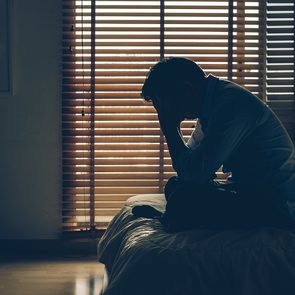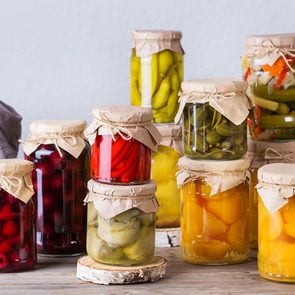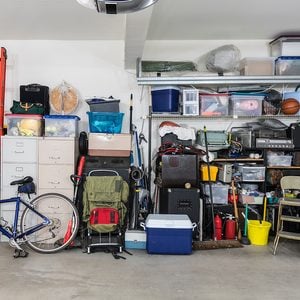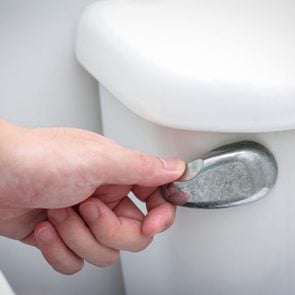By the time you invest in your second or third car, chances are you’ve been around the block enough to know that when it comes time to buy a new vehicle, one of your options is to trade in your old one. But what actually happens to your well-loved minivan that you can’t quite get the smell of french fries out of? According to Gregg Fidan, founder of RealCarTips.com, traded-in cars generally go one of three places:
Recondition and resale
Unless you’re trading in a car that is in nearly perfect condition, with low enough mileage, and a close to recent manufacturing date—in which case, why are you trading it in again?—this is not the road that car is going down. A car that is being traded in after a few small dings, or after the owner gets sick of it and wants something a few years newer, is easy enough for the dealership to fix up, put in some of that new car smell, and resell it to someone looking for a nice car at a slight discount.
Wholesale
Say you’re trading in your old trusty truck for a smaller, more environmentally and pocketbook friendly sedan. The dealership you would choose to go to is probably pretty well known for its smaller, more environmentally and pocketbook friendly sedans, which means not a lot of people are walking in looking for a used truck. So instead of taking a loss and letting it sit around in their lot for years, depreciating in value and standing out from their pristine line up, the dealership will drive it down the road to the lot with all the other trucks, and sell it to them wholesale, or trade for the nice used sedan someone just traded in for a truck. According to experts at The Drive, most cars that are traded in will end up here.
Public auction
The third direction for a trade-in to head is to a public auction. “Most of the cars at a public auction are the worst trade-ins or very rough repos,” Steven Lang, owner of a used car dealership told Popular Mechanics. Cars at public auction can be in extremely rough shape. “I’ve personally seen cars with over 300,000 miles on their clocks rolled back to 120,000 and sold as ‘Miles Exempt’ meaning no guarantee of mileage,” Lang said. This is the destination of cars that look like they are a few kilometres away from spontaneously catching fire. Dealerships and even the general public can take advantage of the dirt cheap cars here, but Lang generally recommends against it unless you are a seasoned mechanic.
Now that you know what happens to trade-in cars, discover the fate of all of the cars that don’t get sold.
I am an anxious traveller. I arrive at airports and train stations extra early. I triple-check all of my documents, feel a tightness in my jaw and a slight clench in my stomach until I’ve arrived where I’m going. Non-anxious people tease me for being a “nervous nelly.”
I used to feel bad about it, seeing it as irrational, weak. Not anymore. I could write a book on this subject—actually, I did: A Brief History of Anxiety (Yours and Mine). I’ve learned to respect my tendency to be hypervigilant.
Recently, I was driving along a country road at the start of a long trip that would mainly be on a highway, the 401 in Ontario. I began feeling that something could go wrong. What if I run out of gas? I worried, even though I still had plenty. So when I spied a gas station just before the on-ramp I was going to take onto the highway, I gave in to my angst and decided to fill up. Just in case.
And that’s when I discovered that one of my front tires was badly deflated. If I’d overpowered my unease, talked down my anxiety, the tire would’ve blown at speed on the highway. My urge to plan ahead even though it wasn’t strictly necessary saved me from a potentially catastrophic scenario.
The Benefits of Anxiety, According to Psychologists
A growing number of psychologists and neuroscientists are getting the message out that anxiety and other negative feelings have a role to play in our lives. Tracy Dennis-Tiwary, who recently published Future Tense: Why Anxiety Is Good for You (Even Though It Feels Bad), thinks our culture goes overboard in demonizing difficult emotions.
She knows what it’s like to get swamped by anxiety. “I remember a period at work when there was a lot going on,” says the professor of psychology and neuroscience at the City University of New York’s Hunter College. Worries kept waking her up at 4 a.m. “It was like a yucky cloud of free-floating anxiety,” she says, and it kept her from falling back to much-needed sleep.
Instead of trying to suppress this disconcerting feeling, however, Dennis-Tiwary leaned into it. “If you sit with the anxiety, you have an opportunity to glean information,” she says. “For me, this one important ball I’d dropped at work finally rose to the surface of my mind. When I recognized this niggling thing, and gave it space, I learned from it. I wrote down two or three things I could do to address it.” The next morning, she felt calmer.
Psychologist Todd Kashdan, director of the Well-Being Lab at George Mason University in Virginia and co-author of The Upside of Your Dark Side, is a critic of what he calls “gung-ho happy-ology.” We don’t always have to be smiley and serene, or worry that there’s something wrong with us. Sometimes, he says, it’s right to worry. Fear heights? Good, because you won’t be the person who falls off a cliff while taking a selfie.
These experts wonder if the natural role that anxiety plays in our lives is being forgotten. For example, the World Health Organization (WHO) announced in March 2022 that the prevalence of anxiety and depression had increased globally by 25 percent over the year before (which was the earlier part of the pandemic). It called the finding “a wake-up call to all countries to step up mental health services and support.” Do we know for certain this data represents a public-health crisis? Or could it mean that millions of folks are quite rightly feeling uncertain, stressed out and afraid?
The difference is important. For example, the U.S. Department of Health and Human Services now recommends that family doctors do routine screenings for anxiety. It’s a positive development in that it recognizes the impact that anxiety disorders can have on those at risk. But what if initiatives like this funnel some of us into unnecessary treatments and medications? Could it make us lose sight of the benefits of our doubts and “what ifs”?
We can experience healthy, often completely valid, periods of distress without being categorized as mentally ill, according to behavioural psychologists. Anxiety is an adaptive strategy in human evolution. It helps us to prepare for the uncertain future, “to remain vigilant,” Dennis-Tiwary says. Anxiety prompts us to resolve projected unknowns by planning and imagining, by plotting out possible scenarios.
“From an evolutionary point of view, anxiety is the best emotion to help us manage uncertainty because it forces us to run those ‘what-if’ simulations,” she says. “That’s what it’s good for.”
Leveraging Anxiety in Our Lives
Likewise, neuroscientist Wendy Suzuki of New York University (NYU) points out in her book Good Anxiety: Harnessing the Power of the Most Misunderstood Emotion that “if we simply approach anxiety as something to avoid, get rid of or dampen, we not only don’t solve the problem it’s alerting us to, but actually miss an opportunity to leverage the generative power of anxiety.” By generative, she means that it can prompt us to move out of a situation that’s no longer working, to find the energy we need to get unstuck.
When we’re in an anxious state, the amount of dopamine in our brains increases, which prompts us to take action. In evolutionary terms, millions of years ago that might have meant looking for shelter to evade predatory animals. Today, it might mean leaving a job because of a predatory boss.
By not facing our anxiety, we lose its benefits, and can make things worse. Case in point for me: hiding unopened envelopes from the tax department in a drawer—even if they could be just the routine updates that self-employed people like me receive—until I’ve turned it into a full-blown phobia.
Says Alice Boyes, who has a PhD in clinical psychology and wrote The Anxiety Toolkit, coping with unpleasant feelings by avoiding them just reinforces your insecurity, because you’re not getting better at solving the problem: “Over time, you will feel less and less competent.”
The key is to manage unease before it overtakes us, like tending a garden so the weeds don’t spread. But how? According to NYU’s Suzuki, solutions include meditation, exercise, compassionate connection such as volunteering, access to nature and mentally reframing what we’re experiencing. For example, in her book Suzuki writes about a startup entrepreneur who was beginning to feel daunted by everything that could go wrong in his high-stakes venture. This generated all kinds of “what if?” anxiety that kept him sleepless.
He was, in psychological parlance, catastrophizing. After talking to a mentor, he found a new tool: a “reframe.” He turned “what ifs?” into a goal-directed to-do list: “If this were to happen, then what could I do? Well, I could do X.”
Reframing Fears
Dennis-Tiwary agrees that reframing is crucial. She points to a 2013 Harvard study in which socially anxious people were asked to speak in public. The researchers told some of them that having sweaty palms and a dry mouth or shaky knees was a good sign, a “positive coping tool” that optimizes the body for performance. The nervous speakers who heard this message had lower blood pressure and a slower heart rate. In other words, they shifted to that sweet spot where they were ready for the challenge, but not distracted and alarmed by their own nervousness.
That’s a pretty remarkable discovery. What it says is that we can reframe our fears so that they help us.
Several years ago, I was the last in a long queue of speakers at a TEDx event. The theatre was over-air-conditioned. I sat there shivering and growing tense, worrying that I would forget my speech about a book I’d recently written about death and dying. The longer this mind-body feedback loop of physical tension and mental anxiety went on, the worse it got, until my legs felt so rubbery that I feared I would fall off the stage. It’s a miracle I made it through my talk.
Knowing what I do now, I would have paced and stretched in the hallway to keep my body warmed up and my breathing calm while I waited, not unlike an athlete before an event. I still would have been nervous, but I would have been taking steps to manage it.
“One of the key problems is that our perceptions about anxiety stop us from believing we can manage it,” says Dennis-Tiwary. She argues that anxiety isn’t the problem. “It is the messenger that tells us we’re facing uncertainty and need to rise to the challenge. Or it’s pointing us to ways that our life needs to change, or that we need support.”
We can manage anxiety by “worrying well,” in Suzuki’s words. This includes meditation. It has been shown to calm the amygdala, the gland in our brain responsible for sending out alarm signals related to fear and anxiety.
Exercise helps, too. Suzuki experimented with some of her students and found that even just a 10-minute workout helped them feel less anxious before an exam. So, hit the gym, enjoy the dance floor or go for a hike. Just spending time in natural light and in green spaces, what the Japanese call “forest bathing,” can restore our sense of psychological balance. After all, we evolved in companionship with nature.
Because humour increases oxytocin, a hormone that enhances social bonding and relatedness, I sometimes listen to stand-up comedy to calm down. Social connection, touch and a grounding perspective on others’ suffering can also soothe us, which is why volunteer and community involvement helps. (Indeed, isolation during the pandemic may well have been a contributing factor to that uptick in anxiety noted by the WHO.)
These are all well-founded techniques that can keep us from spiralling. The trick, as Dennis-Tiwary says, is to listen to anxiety, then leverage it to make changes or extra plans—just like I did that day I set off on my road trip.
“Then,” she advises, “let it go. It’s a wave that you need to learn to ride.”
Now that you’ve learned the potential benefits of anxiety, find out how to help someone who’s struggling with depression.
Facebook has its benefits. You run into people you haven’t seen in a long time, share favourite throwback photos, and “like” one another’s milestones. But Facebook has a dark side that’s been under more scrutiny than ever lately, with privacy concerns and a preference for polarizing content. Given how divisive the social media site can be, you’ve probably blocked (or at least “snoozed for 30 days”) someone you disagree with, so it’s equally likely that at least one “friend” has you blocked as well.
How to tell if someone blocked you on Facebook
The Facebook algorithm prioritizes content that elicits strong emotions to keep people on the website longer. Unfortunately, that can lead to online disagreements with friends, family or acquaintances—or just people who have different views than you or very strong opinions. If you get into an online fight, the other person could have their feelings hurt and might block you. Here’s how to tell if someone’s blocked you.
Method 1: Scroll through your friend list
You can tell if someone blocked you on Facebook by scrolling your friend list. Social media professional Chad R. MacDonald manages Facebook pages with tens of thousands of followers and is highly experienced with handling Facebook privacy. MacDonald tells us that deactivated accounts’ profiles and profile photos “will still be visible on your friend’s list, although you can’t click on them anymore. Someone who has blocked you won’t show up at all.”
Method 2: Search for their Facebook profile
If you’ve recently gotten into a Facebook kerfuffle with your great-aunt Nora, you might want to check if things are still okay between the two of you. Do a general search for her name in the Facebook search results bar at the top of the page. If Auntie Nora shows up as a friend, you’re still on good terms, and there’s no need to worry. However, if the widget on her search result reads “Add friend,” this means that she has unfriended or blocked you. A simple unfriend is less worrisome than a block, and you can take it as a sign that there’s room for the two of you to rebuild your relationship. If you’re still able to see her public posts, you have not been blocked.
If they don’t show up in search results…
If the person doesn’t show up in search results at all, the user has either deleted their profile or has blocked you. And let’s be frank, if the two of you were arguing it’s more likely to be the latter. To double-check, ask a mutual friend to search the person’s name in their Facebook search bar. If the person shows up in their results but not yours, you have some relationship mending to do.
“If the search yields a result with an active page, it’s clear that you’ve gotten the chop,” says Krystin Dunbar, Senior Campaign Strategist at digital agency Union. But Dunbar cautions this could also mean the person has just changed their privacy settings. “Privacy settings can be changed so that accounts don’t show up in a [Facebook] member search—so this isn’t a foolproof method.”
Method 3: Try to tag them in a photo
Usually, when you try to tag someone in a photo, Facebook will suggest their name once you start typing it. But if you type the person’s name and nothing autofills, this could be because the person has blocked you. Same goes for trying to invite that person to an event or to join a group.
Method 4: Try to access their profile
Of course, their omission from your regular friend list and search results will prevent you from just going to the profile page of someone who’s blocked you. But if somehow you have a link that goes directly to their profile, it should show up as “unavailable” if they’ve blocked you.
How to tell if someone blocked you on Facebook Messenger
It is possible for someone to block you from messaging them on Facebook Messenger even if they haven’t blocked your profile on Facebook, and this would indicate they are unwilling to be more than just a social media acquaintance. To check if someone has blocked you on Facebook Messenger, try sending a message to their profile. If you get an error message that reads “Message Not Sent,” “This person isn’t receiving messages at this time,” or “This person isn’t available at the moment,” then the person has either blocked you or deactivated their account.
Next, find out why you need to stop commenting on those viral Facebook memes.
Butter is expensive, so don’t waste a single bit of it—including what’s on the butter wrapper.
When peeled off the stick of butter, the wrappers have a thin layer of butter inside; just enough to put to good use. So don’t throw them out! Here are five butter wrapper hacks you’ll wish you’d known sooner.
How to Save Your Butter Wrappers
Flatten out the butter wrappers and stack them together. Slide the stack into a resealable plastic bag. Stash them in the fridge or for longer storage in the freezer. That way they’ll be handy to grab for all these uses.
These tricks work with all kinds of butter.
Butter Wrapper Hacks
Cover Leftovers
Tamar Adler, author of The Everlasting Meal Cookbook, shares that butter wrappers are great for covering leftovers in a bowl instead of plastic wrap or when lids go missing. Just press a wrapper, butter side down, to the surface of the food to keep air out during storage.

Grease Cake Pans
Our grandmas taught us this baking trick! The butter left on the wrapper is plenty to grease pans for cakes, cookies and brownies. Rub the butter side of the wrapper over the insides of the pan, especially into the corners.

Separate Frozen Food
When getting foods like cookies, cakes, burgers or chicken fillets ready to freeze, butter wrappers will keep them from sticking together. Just place one between each layer before bagging them up for the freezer.
Lightly Grease Skillets
When your frying pan or skillet needs just a little oil, use a butter wrapper instead of cooking spray. Rub the surface of the pan with the wrapper to lightly coat it with butter before cooking.
Shape Marshmallow Cereal Treats
When crisped rice cereal and melted marshmallows are mixed together, it’s super sticky. Instead of coating your hands with butter or nonstick spray, use a butter wrapper. Spoon the mixture into the pan, then use a butter wrapper to press the mixture down.
Discover more cooking hacks that’ll save time (and money!) in the kitchen.
Is your garage door not closing all the way? Does your garage door keep coming back up after it hits the floor? You just need to adjust the travel setting on your door opener. But first, you have to learn what that means.
What’s the garage door travel limit?
The travel controls how far the door goes up and down. Most newer openers have a safety feature that makes the door reverse if it encounters an obstruction.
The garage door travel limit refers to a safety and functionality feature in automatic garage door systems. It consists of two adjustable settings: the “open” and “close” limits. These limits define the maximum points the garage door opener can raise (open limit) or lower (close limit) the door. When the door reaches these pre-set limits, the opener’s motor is signaled to stop operating, ensuring that the door does not travel beyond safe or intended positions. This prevents potential damage to the door, property or people.
If your garage door won’t close all the way, your opener is reading the floor as an obstruction.

How to adjust the garage door travel
All openers have travel adjustments: Chamberlain and Craftsman openers have two set-screws on the back or side of the motor housing. Stanley openers usually have two knobs on the bottom of the motor housing. Genie openers have trip levers on the travel bar that you can reposition to adjust the travel. Adjust according to the instructions for your brand of opener.
Remember that adjusting garage door travel limits involves working with complicated and sometimes dangerous mechanical and electrical components. If you’re unsure or uncomfortable at any point during the mechanical process, it’s recommended to seek professional assistance from a qualified garage door technician.
Always consult your owner’s manual for precise guidance on steps to take and what tools are required.
Next, find out how to prevent garage break-ins.

A Whirlwind Tour of Spanish Gardens
Spain conjures images of white-washed villages, bullfights and fiery flamenco, but have you discovered her gardens? On a recent soujourn in Andalusia with master gardener Donna Dawson and tour operator/leader Jonathan Lord, Spanish gardens enchanted with their diversity and aesthetic beauty. Our tour proved rich in history and culture, as Spanish gardens are an essential element of streetscapes, palaces, mosques and stately patrician homes.

Granada
Since Senorita Gilbert’s high-school Spanish class, I’ve dreamed of the Alhambra palace, an ancient fortress located in Granada, Andalusia. The palace, formerly a stronghold of Moorish rule, remains an outstanding example of medieval architecture, a testament to the role of nature in the everyday life of Islam. The Iberian Peninsula flourished under Muslim rule for almost 800 years and their influence runs deep.
According to Islamic tradition, the courtyard—a walled or enclosed garden—depicts the Quran’s symbol of paradise, while the Alhambra’s fountains and reflecting pools provide solace. The Courtyard of the Lions, with its 12 marble lions representing royalty and power, stands as a focal point of respite in the sultan’s private dwellings.
As I climb terraced slopes on walkways paved with a mosaic of river pebbles, passing cypress hedges, velvet roses, and lemon, orange and pomegranate trees, I was entranced as we reached the Generalife—the sultan’s summer palace and retreat. Within the walls of the Generalife are two major courtyards, The Courtyard of the Cypress, considered the best-preserved medieval Persian garden in Europe. Inside the complex, lies the The Water Garden Courtyard—a long pool with tinkling fountains framed by flowerbeds and colonnades.
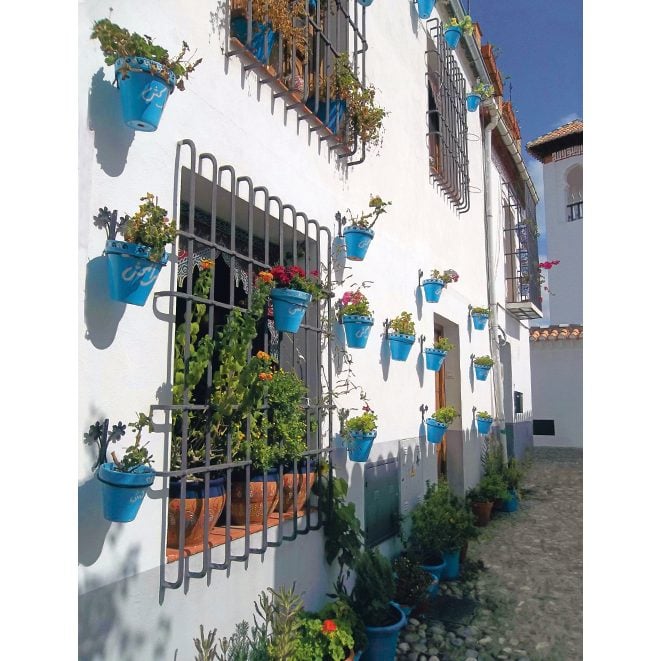
Cordoba
In Cordoba, wandering the Alcazar’s majestic formal gardens, I can imagine the respite Queen Isabella found as she sat and read among the palms, fountains and neatly trimmed boxwood.
At the Mesquita/Great Mosque, a UNESCO World Heritage Site, I learn that the concept of a mosque originated as Mohammed and his followers met for prayer under date palms for protection from the scorching sun. The forest of columns strikes me as the most captivating feature of this sacred place. For three centuries, the Great Mosque of Cordoba held a place of importance for the Islamic community of Al-Andalus. It is from Al-Andalus that Spain’s southern region takes its name Andalusia.
A courtyard, fundamental to any mosque, functions as a place for ritual purification. At the Mezquita, the Courtyard of the Orange Trees with its palms, orange trees and bubbling fountain, not only serves this purpose but an aesthetic one, too.
The Moors ruled the Iberian Peninsula from 711 AD to 1492 until the Reconquista. It was their custom to carry a small bit of nature. From this ancient belief sprang the potted plant. In Cordoba bright blue pots with colourful plants climb whitewashed city walls, creating vertical “gardens in the sky.” In a central square, I come upon a whimsical sculpture of a young woman painstakingly watering each individual pot.
Every year for 12 days in May, Cordoba celebrates the Festival of the Patios. The festival consists of 50 flower-filled patios and terraces, from small private houses to grand mansions and religious institutions, which open up to visitors as part of the competition. Countless pots create a dazzling tapestry of blooms. Many feature climbing and hanging plants, with fragrant blossoms, creating a virtual feast for the senses.
Spaces known as the megaron in ancient Greece and the atrium in Rome were open courtyards within the house, serving as a place to socialize and enjoy intimate family space. The key elements then as today include clay pots, vines, fruit trees, wrought iron grates, ceramic tile and a water feature. Water offers an oasis in torrid summer and its murmur is a sweet song.
The Palacio de los Viana, home to many noble families between the 15th to 20th centuries, remains a private residence with a dozen unique patio gardens open to the public. Some stunning plant material found in their designs include scented jasmine, pink oleander, blue plumbago, lemon and pomegranate trees.

Seville
The bougainvillea-covered Palacio de las Duenas, palatial home of the Duchess of Alba, opened in 2016 after her passing. Today it’s a museum with exquisite Mudejar patios. Lavishly furnished rooms decorated with fine art, antiques, marble sculptures and Flemish tapestries surround a huge central courtyard. Six smaller courtyards sit off the grand central courtyard with its palms, roses, boxwood allees and giant kapok tree.

Maria Luisa Park in Seville, which I yearn to see from a horse-drawn carriage, supplies a welcome green space acting as lungs for this thriving city of 705,000. It reminds me of Central Park in New York. The area is designed in Moorish paradisiacal style with ponds, fountains, lush plantings, Mediterranean pines, stylized flower beds and hidden vine-covered bowers. Not only is the park a botanical garden, it’s home to doves, ducks, swans and parakeets. The statue of poet Becquer and the octagonal fountains of lions and comical frogs spouting water provide interest and entertainment.
The Plaza de Espana, built for the 1929 Spanish American Exhibition, is a brilliant landmark in the North West area of Maria Luisa Park. Venetian foot bridges with bright blue azulejo-tiled handrails cross canals, and colourful balustrades depict a historical scene from each province.

Beyond Barcelona
Barcelona is renowned for Gaudi’s modernisme architecture, but did you know that an hour outside of the city, you can discover two unique Spanish gardens—Santa Clotilde and Marimurtra? What a highlight for the close of our spectacular trip! The Botanical Gardens of Santa Clotilde designed in 1919 by Catalan architect and landscaper Nicolau Rubió i Tuduri recreate the spirit of the Italian Renaissance. Commissioned by the Marquis de Roviralta and named for his wife, the palette is mostly green except in spring when mauve wisteria covers the arches and blue viola interlaces with ivy.
Perched high on a cliff overlooking the rocky Costa Brava, Santa Clotilde is classical in design and symmetry. This garden reflects order and beauty and stands in juxtaposition to the rugged cliffs and raging sea below. Mediterranean species predominate—pines, cypress, cedars and myrtle hedges. Steps lined with ivy give the impression of a grand waterfall and lead to a spectacular viewpoint. I’m mesmerized by Maria Llimona’s Stairway of Sirens, comprising sculptures of beguiling, bronze mermaids with their seashell scales and beauty bewitching mariners and gardeners alike.
Marimurtra Botanical Gardens, created in 1924 by German businessman Karl Faust, houses over 4,000 species of exotic plants from five continents and represents tropical, temperate and Mediterranean climates. Finely trimmed myrtle hedges line the steep cliffs running along the Mediterranean, giving the garden its name: Mari (sea) Murtra (myrtle). From the Linnaeus Temple, I feel the force of the sea crashing on the rocky cliffs, in contrast to man’s cultivated garden. Can we tame nature?
On this adventure, I experienced Spain’s culture and history through her gardens. In their infinite variety, Spanish gardens inspire—offering respite, reflection and a sense of wonder.
For horticultural highlights much closer to home, check out Canada’s must-visit botanical gardens.
It’s one of the most versatile condiments: A base for sautées, a dip for bread, a salad dressing, even a popcorn oil. It’s also one of the healthiest: The utility and rich flavour of olive oil have graced dishes for centuries, heralded in recent decades for the oil’s heart-healthy advantages.
Now a preliminary study from the Harvard T.H. Chan School of Public Health hints at the potential prowess of olive oil as a protective barrier against dementia. With global dementia rates rising as a large segment of the population ages, the role of olive oil to preserve cognitive health deserves a drop of inquiry.
The science behind olive oil and cognitive health
Dementia encompasses many conditions marked by severe impairments in thinking or memory. It’s estimated that nearly 750,000 Canadians suffer from some form of dementia, including Alzheimer’s, a relentless, progressive disease.
“With advances in modern medicine, many people are now outliving their brains,” remarks Kristin Kirkpatrick, MS, RD, LD, of the Cleveland Clinic, emphasizing the importance of brain health.
In summer 2023, Anne-Julie Tessier, PhD, RD, a nutrition postdoctoral fellow at Harvard, presented a preliminary study at the American Society of Nutrition’s annual conference in Boston that offers promising new insights in the fight against Alzheimer’s. The research suggests that consuming just over half a tablespoon of olive oil daily can reduce the risk of dementia-related death by an impressive 28%. “Our study reinforces dietary guidelines recommending vegetable oils such as olive oil,” Dr. Tessier stated in a press release. “These recommendations not only support heart health but potentially brain health, as well.”
Even more compelling is the evidence that replacing mere teaspoons of processed fats like margarine and commercial mayonnaise with olive oil cuts down the risk of dementia mortality by eight percent to 14%. Dr. Tessier added: “Opting for olive oil, a natural product, over these fats is a safe choice that may reduce the risk of fatal dementia.”
What’s the science behind this powerful gift from nature? “Some antioxidant compounds in olive oil can cross the blood-brain barrier, potentially having a direct effect on the brain,” Dr. Tessier explains. “It’s also possible that olive oil benefits brain health indirectly by benefiting cardiovascular health.”
Dr. Tessier noted that while the research suggests a link between olive oil and a reduced risk of dementia, it doesn’t conclusively prove this. Further in-depth studies, like randomized controlled trials, are required to verify these effects and to determine the best amount of olive oil to consume for maximum benefits.
That said, the connection appears promising. Another pivotal study from Harvard, published in the Journal of the American College of Cardiology in 2022, spotlights olive oil’s protective nature. It not only aligns with Dr. Tessier’s deductions about dementia but also points to a broader range of benefits. This study illustrates how olive oil can mitigate the risks of premature death, especially from conditions like cardiovascular and neurodegenerative diseases. Echoing this sentiment, Marta Guasch-Ferré, PhD, an author of the study and Associate Professor of Nutrition at Harvard, stated: “Swapping animal fats with plant-based oils can be a key to preventing chronic ailments and extending lifespan.”
Find out how magnesium may lower your dementia risk.
Embracing olive oil beyond cognitive benefits
The health benefits of olive oil spread far beyond brain health—it is credited with reducing chronic inflammation and might even inhibit cancer cell growth. Kirkpatrick compared olive oil with antioxidant-rich foods like blueberries and broccoli: “Olive oil tends to have a very high capacity of antioxidants,” she emphasized, highlighting its potential in cancer prevention.
Here are more high-antioxidant foods worth adding to your cart.
If you’re eager to incorporate more of this liquid gold into your diet, Kirkpatrick suggests a daily intake of one to three tablespoons, highlighting its versatility: Spritz olive oil on toast or drizzle it over a salad—but note that olive oils are not created equally. Opt for extra virgin olive oil for the best health benefits. Stored in a dark bottle, it should be tightly sealed after opening. Light and air can compromise the taste and quality of extra-virgin olive oil.
Next, find out how the MIND Diet meal plan can reduce your risk for Alzheimer’s.
Waking up at night to pee isn’t that uncommon for most people, and generally it’s nothing to be concerned about. However, if you’re getting up several times each night, it could be classified as nocturia, or frequent nighttime urination, which isn’t necessarily healthy in the long term.
Nocturia itself is not a disease or condition, notes Kirsty M. Borawski, MD, associate professor of urology at the University of North Carolina-Chapel Hill School of Medicine. Instead, it’s a symptom—one that could be triggered by anything from drinking too much fluid, uncontrolled diabetes, sleep apnea, and more. In early adulthood, frequent nighttime urination tends to affect women more often than men, while this is reversed in later life, says Dr. Borawski.
What is nocturia?
Typically, the body produces less urine at night, so people can sleep six to eight hours (the recommended amount) without waking. For these nighttime episodes to be considered nocturia, they have to come in between periods of sleep.
Interrupted sleep, in general, is not good for your health, and chronic nocturia is no exception.
“Nighttime urination is linked to increases in mortality, especially among elderly people,” says Erin L. Ohmann, MD, an attending urologist at Montefiore Health System and assistant professor of urology at Albert Einstein College of Medicine in New York City.
If you’re elderly, making that trip to the bathroom in the middle of the night, especially if the area is poorly lit or obstructed, can lead to falls or fractures, says Dr. Ohmann. What’s more, poor sleep leads to daytime fatigue and changes in alertness and mood.
Here are the causes of nocturia.
Drinking too much fluid
This seemingly harmless habit is the most common cause of urinating excessively at night—especially if you’re imbibing anything containing caffeine or alcoholic within two to three hours of bedtime. Both caffeine and alcohol are diuretics that make your kidney produce more urine in a rapid time frame, explains Dr. Ohmann.
There’s an easy fix here: Don’t drink caffeine or alcohol before bedtime and, in general, curtail your intake of fluids within four to six hours of retiring. Visit the bathroom last thing before you go to bed. (Follow this sleep hygiene checklist to establish a nighttime routine that’s more conducive to deep, restful sleep.)
As people age, bladders don’t have as much capacity, so even drinking the same amount you always have may result in more trips to the bathroom when you’re older. Just be careful not to limit your fluids so much as to risk dehydration.
Medications
Doctors prescribe diuretics or “water pills” such as chlorothiazide (Diuril) and spironolactone (Aldactone), for high blood pressure. These drugs help the kidneys get rid of excess fluid and salt, lowering the amount of blood circulating and easing the burden on your heart. An unfortunate side effect is that it can trigger the urge to urinate through the night.
“If you take this close to bedtime, you will increase your risk for nocturia,” says Dr. Borawski.
If you’re peeing too much at night, you may be taking your medication at the wrong time. But don’t make any changes to medication without consulting your doctor.
Pregnancy
Pregnancy increases the urge to urinate throughout the day—and night. This is due to hormonal changes and the basic mechanics of carrying more weight: the growing fetus puts ever more pressure on your bladder. This is normal, but if you have any other symptoms like burning and pain which could be due to a urinary tract infection, get medical help.
Childbirth can also contribute to nocturia, as can menopause. As women get older, they produce less antidiuretic hormone (ADH), which, in younger years, cuts down nighttime urges to empty. Treatment with desmopressin, a synthetic version of the ADH, is possible.
Enlarged prostate
An enlarged prostate, known as benign prostatic hyperplasia or BPH, is one of the most common conditions affecting older men.
The prostate is a gland located next to and around the bladder and urethra; it produces the fluid found in semen. An enlarged prostate can obstruct the urinary pathway, making it difficult to empty the bladder completely, explains Dr. Ohmann.
Peeing a lot, especially at night, is a hallmark symptom of BPH.
Discover more sexual health facts your urologist wants you to know.
Heart failure and hypertension
Nocturia is a common symptom of heart failure, a chronic condition in which the heart enlarges and has difficulty pumping enough blood. Because the heart doesn’t beat as strongly, salt and fluid build up in your body during the day. When you lie down at night, it retreats into the blood. The bladder then works overtime to get rid of the excess fluid.
Several studies have also linked nighttime trips to the toilet with hypertension. In fact, studies have shown that the worse the nocturia, the higher the blood pressure.
Remember that diuretics are one of the most common treatments for hypertension and heart failure. These drugs may also be causing you to pee more at night.
Here are more heart health tips from real cardiologists.
Diabetes
Undiagnosed or poorly controlled diabetes (type 1 and type 2), is linked with higher urination rates overall, including at night.
“High blood sugar content leads to a diuretic effect,” explains Dr. Ohmann. In other words, all that excess glucose gets flushed out in the urine.
Obesity, a major risk factor for type 2 diabetes, links to both daytime and nighttime peeing.
Check out the latest research on how to prevent diabetes.
Sleep apnea
Sleep apnea is when you briefly but repeatedly stop breathing at night. Nocturia is so common in people with sleep apnea that it’s one of the symptoms doctors look for when diagnosing the condition.
“When someone is not breathing well at night, their body senses that the volume of fluid is overloaded so it sends hormones to tell the kidneys to make more urine,” explains Elena Campbell, MD, a urologist with Ochsner Health System in Baton Rouge.
If your doctor suspects sleep apnea, they will likely send you off for a sleep study to confirm. Treating the sleep apnea (often with a CPAP machine which is a face mask worn at night that delivers a stream of air in the nose) will also resolve the urination issue.
Snoring, a common symptom of sleep apnea, has also been linked with nocturia.
Find out more medical reasons you can’t sleep.
Swelling in your legs and feet
Nocturia can be a sign of daytime fluid retention in your legs and feet, which is known as edema.
“If someone has a lot of fluid on their legs during the day, when they put their legs up at nighttime, the fluid goes back into [blood] circulation, so your body produces more urine in the nighttime,” explains Dr. Campbell. “We recommend elevating your feet above the level of the heart in the [day] to allow some of that urine to pass in the early evening rather than during the night.” Compression stockings may also help.
The swelling itself could be due to something as simple as standing on your feet all day or a more serious medical condition like heart failure.
Here are the heart attack symptoms that are frequently misdiagnosed.
Chronic kidney disease
Your kidneys normally concentrate urine at night in response to antidiuretic hormone. If you have kidney problems, however, the kidneys lose some of that ability, leading to increased urine production, says Dr. Borawski.
Overactive bladder
Overactive bladder is not so much a disease as it is a syndrome, meaning it involves a combination of symptoms, one of which is peeing a lot.
“It’s characterized to be a combination of frequent urination, the urge to get to a bathroom right away and incontinence, meaning you can’t make it to the bathroom in time,” explains Dr. Campbell.
One cause may be involuntary muscle contractions, but the reasons aren’t always clear.
Treating nocturia
The best treatment for nocturia is to do identify and treat any underlying causes, says Dr. Ohmann. Many of the factors contributing to nocturia are interrelated (for example, sleep apnea, diabetes, and hypertension). And about half of patients report having at least three conditions contributing to their nighttime excursions.
The first option for treatment is behavioural changes like drinking less caffeine and alcohol before bed, elevating your feet, and making sure you’re taking diuretics at the appropriate time. Behavioural therapy, including pelvic floor muscle exercises, is also an option.
Simple sleep hygiene measures can also help. This includes keeping a regular sleep schedule and keeping your bedroom dark at a comfortable temperature.
When to see a doctor about nocturia
If you suspect nocturia is due to anything other than your daily behaviours (drinking too much before bed, for instance), especially if it’s robbing you of sleep, you should see a doctor. It’s also time to get medical help if you see blood in your urine, if you have any abrupt changes in your symptoms or if you think you might have an infection (you’d probably also be experiencing burning when you urinate), says Dr. Borawski.
“There are many, many causes of nocturia,” adds Dr. Ohmann. “Seeing a provider can help with quality of life and prevent complications.”
Now that you know the possible reasons you’re waking up at night to pee, find out 20 symptoms you should never ignore.
Kathy Xu, a high school teacher in Singapore, had always wanted to see a shark in the wild. The opportunity finally came in 2011, when she went on a snorkelling trip to the Ningaloo Reef, off the coast of Western Australia. Not only was she not scared of the whale shark, the then 29-year-old was so inspired by its beauty and grace that tears sprang to her eyes inside her snorkel mask. “I was screaming with excitement inside, while still trying to keep calm and enjoy the moment,” she says.
After returning home to Singapore, Xu learned about the shark trade taking place at one of Indonesia’s largest fish markets. In the village of Tanjung Luar, on the island of Lombok, shark parts including meat, cartilage and teeth are cut up for export. Most prized are the fins, which fetch high prices because of the popularity of shark-fin soup.
Curious, Xu packed her bags and headed to Tanjung Luar. There, she spoke with several fishermen. Shark fishing is risky and involves hard physical work, but it is one of few ways for them to provide for their families.
The fishermen were knowledgeable and felt a great sense of pride for the local sea life. Once they heard that Xu liked to snorkel, they urged her to visit the coral reefs near the fish market. The reefs were stunning, teeming with life and colour. Xu was confident that ecotourism was the solution—a way the fishermen could make a living without having to catch sharks.
“I told them I’d pay them to take tourists out to see these snorkelling havens,” she says.
Together, Xu and the fishermen came up with the idea of snorkelling boat trips, and a deal was struck.
In late 2012, Xu quit her full-time teaching job to focus on building The Dorsal Effect, an ecotourism business she hoped would help save the declining shark population in Lombok’s waters.
Initially, Xu struggled to find investors, but in 2013 she won the Young Social Entrepreneurs competition funded by the Singapore International Foundation and was awarded the equivalent of US$7,500. She purchased snorkel gear, life vests and equipment and paid for boat repairs and refurbishments for the fishermen.
In late 2013, The Dorsal Effect launched its first boat trip. Snorkellers paid US$120 for a one-day excursion to explore places the local fishermen know about but could not be found on a Google search. It provides a much more reliable income for the fishermen than the precarious, and often dangerous, job of shark fishing.
In 2019, while working on a research project, Xu and Singapore-based shark scientist Naomi Clark-Shen found a female Rhynchobatus cooki, or clown wedge fish, at Jurong Fishery Port in Singapore. A relative of the shark, the species had not been seen for more than 20 years and was believed to be extinct. The discovery gave scientists hope, and it could be grounds for an in-depth conservation study.
For now, Xu, 41, is proud of the small changes she sees happening on Lombok, from the fishermen who now have a new way to earn an income to the school children who learn about sharks on tours with The Dorsal Effect. In the past decade, global demand for shark fins has declined—a promising result of conservation campaigns—but stricter government regulation is needed.
“I love the grace of sharks and decided that I wanted to change the negative opinion people have of them,” Xu says. “By encountering a shark respectfully, in its natural habitat, maybe there could be more compassion and empathy toward marine wildlife.”
Check out more good news stories to brighten your day.

The History of Pointe Claire, Quebec
Pointe Claire, Quebec, has been my beloved hometown for more than 70 years. Now part of the Greater Montreal region, the city of about 31,000 was settled in the late 1600s during the French regime. In 1710, a stone windmill was built on a point of land on the southwestern part of Montreal island, on the shore of Lac St. Louis. The windmill was primarily used to grind corn into meal, and occasionally for protection from hostile warriors from across the river. The Parish of Pointe Claire was established in 1713; the area consisted of French seigniories—farms sectioned in strips stretching inland from the water. Early transportation was by boat, or by horse and wagon once the Bord du Lac/Lakeshore Road was built during the 1700s.
In 1759, British General Wolfe won the battle of the Plains of Abraham in Quebec, thus winning the area for Britain. The existing French settlers were allowed to keep their farms, language and civil/religious governance.
By 1810, summer houses owned by English speaking part-time residents from Montreal lined the lakeshore. In 1855, the Grand Trunk Railway was built from Montreal through Pointe Claire and westward to Toronto. Canada as we all know became a unified country in 1867.
By the 1890s, the summer houses developed into more permanent communities, attracting new residents. For example, Swedish-born Otto Lilly and his Canadian wife and family bought the Perrier farm in Pointe Claire and moved there from the city of Montreal in 1893. Otto built Cedar Avenue from the edge of the water inland to the railway tracks. He created and sold single home lots on both sides of the road, built an English Protestant school (Cedar Park Elementary School) in 1895, and started a Presbyterian church mission in 1899. The congregation became Lilly Memorial Church in 1923, and Cedar Park United Church in 1955.
Check out 10 historical landmarks every Canadian needs to visit.

Happy Memories
The village of Pointe Claire was incorporated as a town in 1911. In 1950, when our family moved into our little red brick bungalow, we soon had friendly neighbours, schoolmates and church friends. Together we enjoyed many community activities: New Year’s Eve partying, marshmallow toasting, backyard swinging and jungle gym climbing, swimming, skating, skiing, singing, dancing, picnicking and reading in the library. My parents shopped for groceries in the Village, as the oldest section of Pointe Claire become known, and bought eggs and corn from the Priests Farm. By 1960, Pointe Claire Shopping Centre was built. It provided our food, banking, pharmaceutical and other services. We no longer needed to travel to downtown Montreal, except for my father’s office work, and my university courses at McGill (1966-1970).
After our wedding in 1972, my husband declared that he liked Pointe Claire’s green areas and fully grown trees, and he wished to buy us a home here. We did, and my love affair with my home town continued. We befriended new neighbours and church folk. Our two children were born here in the Lakeshore General Hospital, and grew up with their own set of local friends and activities.
The City of Pointe Claire’s symbol is the 300-year-old windmill. During the last 30 years, Pointe Claire folk have gathered around the windmill at sunrise for a bilingual, multi-denominational Easter service, and “Thine is the glory/A toi la gloire…” rings out beside the water as Canada geese fly in a V overhead. There are always plenty of smiles, greetings and well wishes. Pointe Claire people always look out for one another.
If you enjoyed this look back at the story of Pointe Claire, Quebec, you won’t want to miss our roundup of great day trips from Montreal.




